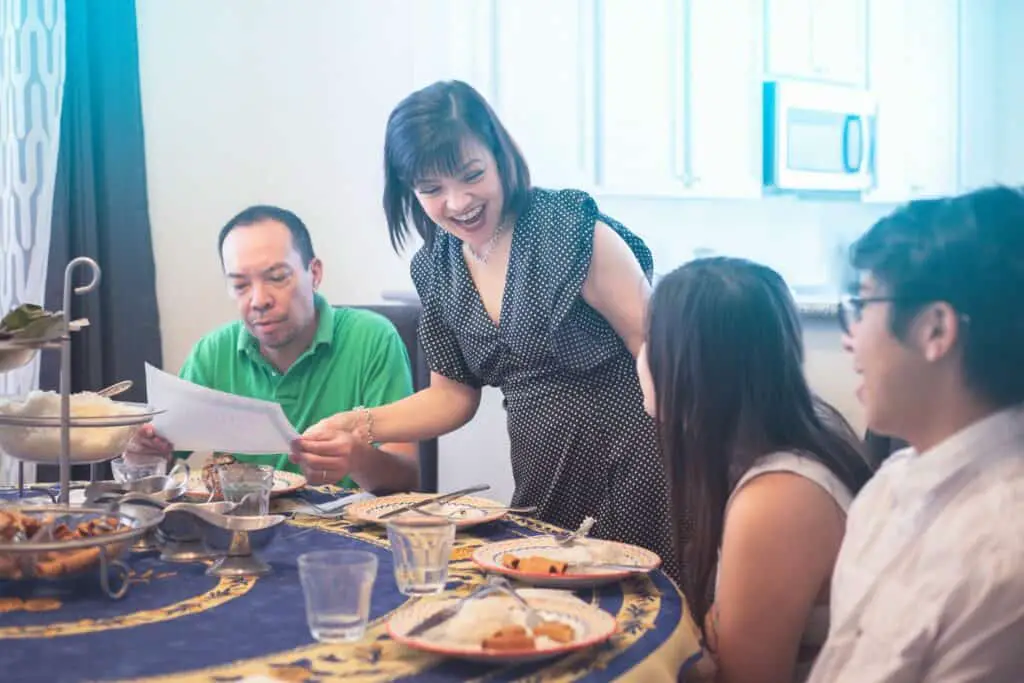
There are many nuances in each culture, that’s for sure. So what about the Filipino culture? From how many times traditional filipinos eat in a day, to more nuanced traditions, read on to learn a little bit more about the filipino culture.
On average, Filipinos eat 5 times per day. Traditionally, these meals consist of: breakfast, snack, lunch, snack, and dinner. The main meals (breakfast, lunch and dinner) usually includes rice, while the snacks in between consist of filipino sweets such as ensaymada or rice cakes.
If you are curious to learn more about the different nuances in Filipino culture that you may not have known, keep reading.
Filipinos have 5 meals a day
Filipinos typically have five meals a day: breakfast, a snack, lunch, another snack, and dinner. Moreover, rice is usually included in breakfast, lunch and dinner. The frequent eating is due to a few reasons. Many Filipinos get up early and have breakfast early, so they need a snack after breakfast to get them through to lunch.
We like to eat with our hands
When we like the food, we eat with our hands. There are a few reasons why Filipinos tend to eat with their hands. For one, it’s generally seen as being more intimate and personal than using utensils. When you’re eating with someone, it’s a way of showing that you’re comfortable with them and that you’re willing to share in the experience. It also allows you to get a better sense of the food itself, both in terms of texture and flavor.
When you’re using your hands, you can pick up on subtle nuances that you might miss if you were just using a fork or spoon. Of course, there’s also the fact that it’s simply more fun to eat with your hands. It’s a good way to bond with friends or family members over a meal. And at the end of the day, isn’t that what food is all about? Sharing a delicious experience with the people you care about?
Traditionally, filipino breakfast consists of rice
Traditional filipino breakfasts both have rice and egg in them. Some traditional and more common filipino breakfasts are:
- Tapsilog: consists of tapa, egg and rice
- Bangsilog: consists of bangus, egg and rice
- Hotsilog: consists of hotdog, egg and rice
- Longsilog: consists of longganisa, egg and rice
And you guessed it: most often, we eat this using our hands.
So why does the traditional filipino breakfast consist of rice?
Traditional Filipino breakfast typically consists of rice because it is a carbohydrate that provides the body with energy to start the day. Rice is also a staple food in the Philippines, meaning that it is always available and is relatively cheap. Traditionally in the Philippines, breakfast is often considered the most important meal of the day, so Filipinos tend to eat a heavy breakfast for the day ahead.
Did you know filipinos love eating with their hands? Click here to find out why.
Having meals together as a family is very important to us

There are many reasons why eating together as a family is important for Filipinos. For one, it helps to foster a sense of togetherness and unity. Eating together gives family members a chance to catch up with one another and bond over shared experiences.
Additionally, it provides an opportunity for parents to teach their children about Filipino culture and traditions. Moreover, eating together can help to promote healthier eating habits. When families eat together, they are more likely to make healthier choices and eat more nutrient-rich meals.
Finally, sitting down for a meal can be a stress-reliever and a chance to relax and enjoy one another’s company. In short, there are many reasons why eating together as a family is important for Filipinos. It helps to create a stronger sense of unity, teaches children about their culture, promotes healthier eating habits, and provides a much-needed reprieve from the stresses of daily life.
Family and community is very important to us
Filipinos place a high importance on family and community. This is likely due to the fact that, historically, Filipinos have had to rely on family and community members for help and support. In a culture that emphasizes close relationships, Filipinos often turn to family and friends for assistance with everything from finding a job to dealing with personal problems.
Additionally, Filipinos are typically very hospitable and generous people, always willing to help out a neighbor in need. As a result of these values, Filipinos typically maintain strong ties to their families and communities. These close relationships provide Filipinos with a sense of identity and belonging, two things that are very important to the Filipino people.
Everyone is related to everyone
When filipinos first meat a fellow filipino, most often times, one of the first questions that will pop up is: where are you from in the Philippines. This is often followed up with a statement by the other person saying they know a person or have a relative who lives in that area.
Filipinos love trying to connect the dots, even if it really makes no substantial difference to your relationship with them.
We all have a relative who’s a nurse or an engineer (or both)
For many Filipinos, nursing and engineering are seen as two of the most stable and respected professions. In a country where nearly a quarter of the population lives below the poverty line, these jobs offer the promise of a good salary and job security.
In addition, both nursing and engineering require extensive training and education, which is often beyond the reach of most Filipinos. As a result, these professions are seen as a way to improve one’s social status and provide for one’s family.
Moreover, with the recent globalization of the Philippines economy, there has been an increasing demand for Filipino nurses and engineers in other countries. This has created even more opportunities for Filipinos who choose to pursue these careers.
Because of these, many people choose these two career paths, and as a result, most filipinos you know will have relatives in these two professions, or are in the professions themselves.
Opo as a sign of respect
The word “Opo” is the respectful way of saying “Oo” or “Yes”. As young children, we are taught that we have to say “opo” to the elderly, and as adults, we continue to say it to show our respect to the person we are speaking to. It is typically used in response to an elder or someone in a position of authority, such as a teacher or boss. When used in this way, “opo” conveys deference and obedience. In addition to being a sign of respect, “opo” can also be used as a way to show humility.
Ultimately, “opo” is just one small part of the Filipino language, but it plays an important role in the culture. By using this word, we are able to show respect for our elders and authority figures, while also maintaining our humility.
We call everyone ate or kuya – even if we’re not related
In the same vein as using “opo” to those we respect, we usually also use the work “ate” or “kuya” to people we are close to that we respect. Calling someone “ate” (ah-teh) or “kuya” (koo-yah) is a sign of respect in the Philippines. It’s similar to calling someone “auntie” or “older sister” for a woman, and “uncle” or “older brother” for a man.
This is especially common among children, who would use these terms for adults who are not related to them. However, it’s also common for Filipinos of all ages to use these terms with each other, regardless of whether they’re related or not. The reason for this is that Filipinos generally place a high value on family relationships.
By using these terms, Filipinos are indicating that they see the person as part of their extended family. In a society where family is everything, this is a sign of the highest respect.

